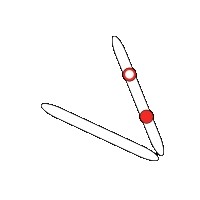
Swimming at low Reynolds numbers (in viscous fluids, or at small length scales) is an important aspect of biology, where it plays a role in the study of micro-organisms, and in robotics, for the control of small-scale mobile systems. In collaboration with Professor Anette Hosoi and Lisa Burton of MIT, I am applying the connection vector field and optimal coordinates approaches from my geometric mechanics work towards gaining a clearer insight on the mechanics of swimming in Low Reynolds number conditions.
Our first result in this area was an explanation of an optimal stroke pattern for a three-link swimmer. Previously, Prof. Hosoi’s group had found that optimally-efficient strokes for a three-link swimmer trace out a “peanut” shape in the space of joint angles. This result was found numerically, but by comparing this stroke with the principle component of the Lie bracket for the system, we can see the factors that generate this shape, based on two general rules:
- The energy cost of the stroke scales with its path length in the shape space
- The net displacement is given by the area integral of the Lie bracket function over the region enclosed by the stroke
The optimal stroke encloses the two negative wells in the Lie bracket while avoiding the positive quadrants that would counter the effect of the wells.
